A conflict the White House once hoped to moderate has gone from “over the top” to out of control.
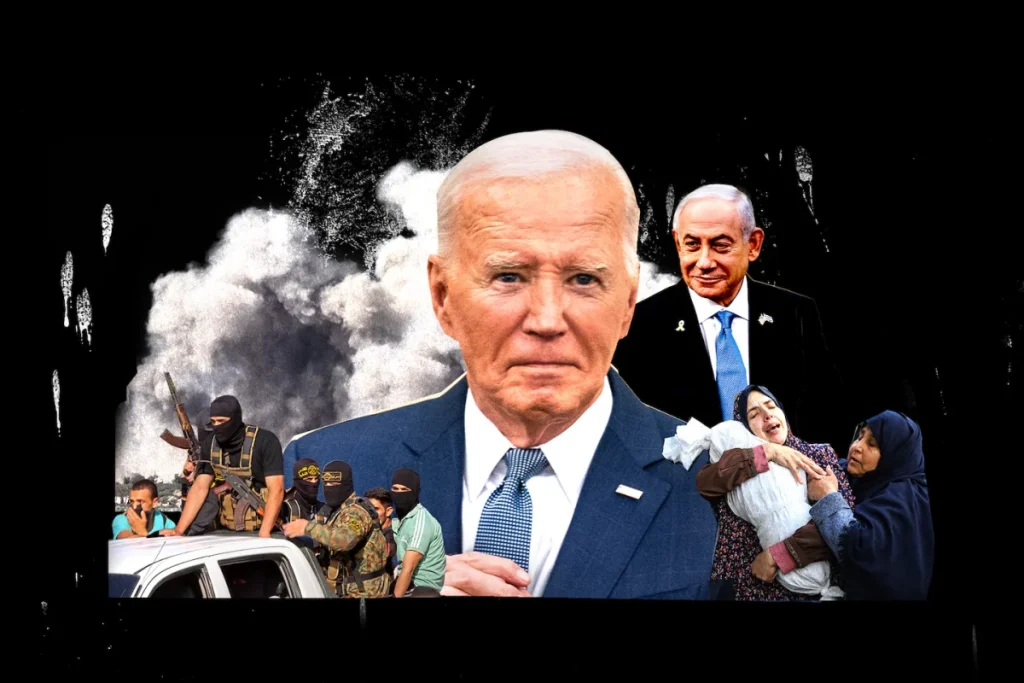
By Karen DeYoung and Missy Ryan, The Washington Post, October 3, 2024
On the morning of April 1, President Joe Biden’s top national security aides had a stern message to deliver to Israel as it prepared to launch a military operation in Gaza’s southernmost city of Rafah: Its northern Gaza offensive against Hamas militants had already killed tens of thousands of Palestinian civilians. The same thing could not happen again.
As Israeli Ambassador Michael Herzog arrived at the White House Situation Room to attend a virtual meeting that Jake Sullivan, Biden’s national security adviser, and Secretary of State Antony Blinken were about to hold with their counterparts in Tel Aviv, the Israeli diplomat pulled Blinken aides aside with startling news.
Less than an hour earlier, he said, Israeli warplanes had struck an office building in Damascus, targeting the Syrian headquarters of Iran’s elite Islamic Revolutionary Guard Corps, a building next to the Iranian Embassy.
Later that same day, Herzog alerted the White House with news of yet another strike.
Missiles from Israeli drones operating in Gaza had struck a clearly marked convoy of the Washington-based World Central Kitchen, one of the few organizations able to get supplies to starving civilians. Seven people were dead, including aid workers from the United States, Britain, Poland and Australia, along with their Palestinian driver.
It was a terrible mistake — a tragedy, Herzog said. Israel, he vowed, would investigate and hold those responsible to account.
In a statement, an outraged U.S. president said that despite months of urging, Israel “has not done enough” to protect aid workers and civilians from its attacks in Gaza.
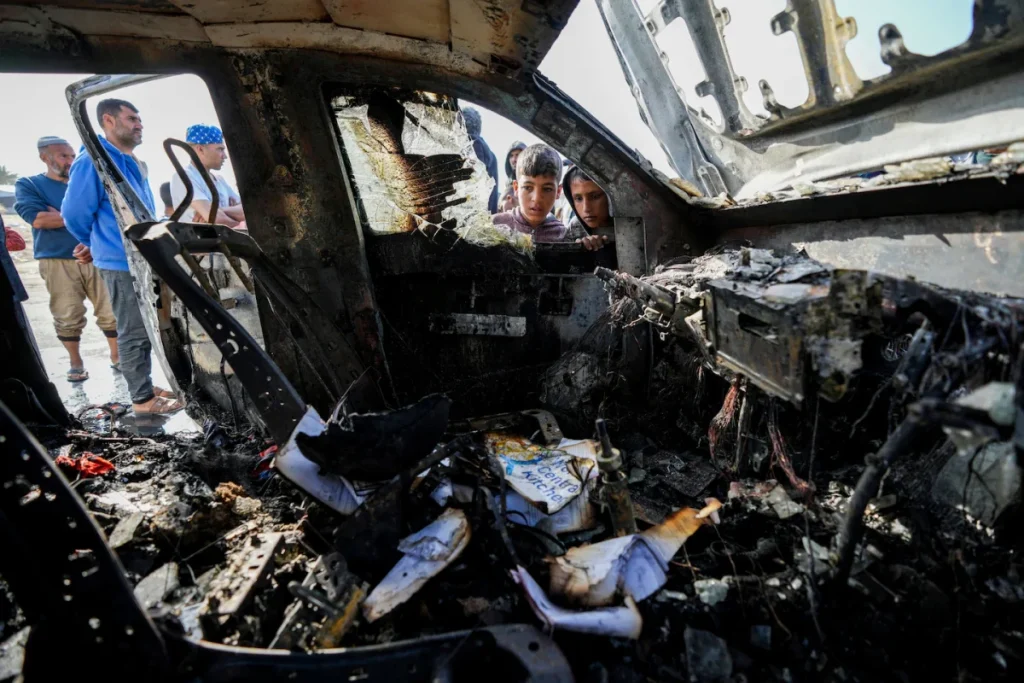
Six months into the war, the events of that day encapsulated for Biden the dual challenges he has faced since the conflict began with Hamas’s murderous Oct. 7 incursion into Israel that left about 1,200 people dead and 250 taken hostage.
While personally committed to supporting Israel’s goal of obliterating Hamas, Biden had repeatedly stressed to Prime Minister Benjamin Netanyahu the need to adhere to international norms requiring protection of civilians and provision of humanitarian aid — guidelines that Israel had just as often shown itself unable or unwilling to follow.
Biden’s overriding concern was preventing an all-out conflagration in the region. Yet as he sought a path for long-term peace and stability for Israel, Biden was undermined at every turn by Netanyahu’s conduct of the Gaza war, his refusal to consider establishment of a Palestinian state, and the territorial ambitions of his right-wing government in the occupied territories.
Lebanon-based Hezbollah, a far more formidable foe than Hamas, had already joined the fight, along with other Iranian-backed groups in Iraq, Syria and Yemen.
This account of how Biden and his team have navigated the most serious Middle East crisis in decades — focused on key moments that illustrate the dramatic ups and downs of the past 12 months — is drawn frominterviews with more than a dozen senior U.S. and Israeli officials, most of whom spoke on the condition of anonymity to talk about sensitive diplomacy and decision-making.
Unchecked War
A year that began with Hamas’ devastating attack in Israel has spiraled into catastrophe for Gazans and triggered a wave of violence in Lebanon, with tens of thousands of people killed — and no end in sight.
Despite strenuous U.S. diplomacy and negotiations for a cease-fire, the Gaza war goes on. The enclave is buried under the rubble from thousands of Israeli airstrikes and ground attacks, with more than 40,000 Palestinians killed and over a million without basic shelter and sustenance. Hamas, while severely damaged, survives and continues to hold hostages.
The regional conflagration Biden sought to avoid now appears all but inevitable. In a new offensive that started late last month, Israel has launched hundreds of airstrikes and is sending ground forces into Lebanon against Hezbollah, the strongest of Iran’s proxies, killing hundreds of civilians and militants. After a targeted Israeli bombing in Beirut’s southern suburbs killed Hezbollah leader Hasan Nasrallah, Iran responded Tuesday by lobbing hundreds of ballistic missiles into Israel.
As the United States stands accused of complicity in what much of the world charges are Israeli war crimes in Gaza, the widening conflict has exposed, not for the first time, the inability of a great power to bend either recalcitrant allies or smaller adversaries to its will.
“It’s perfectly legitimate to say that we didn’t create the situation; we are dealing with bad actors and have enemies and there’s only so much we can dictate to our friends,” said Middle East expert Vali Nasr, former dean of the Johns Hopkins School of Advanced International Studies and now a senior professor there. “But the fact of the matter is we have certain objectives in the region and … basically haven’t been able to achieve any of it.”
“For all of this intense diplomacy, has it enhanced our leadership stature around the world as a power to shape events?” Nasr said. “The past year does not suggest that that’s the case.”
Blindsided

As fall arrived in 2023, the Biden administration was satisfied with its Middle East policy and optimistic about its future. In an essay he wrote for Foreign Affairs magazine — submitted for publication just before Oct. 7 but hastily amended days after the Hamas attack — Sullivan lauded the administration’s efforts, writing that the Middle East “was quieter than it has been for decades.”
Secret U.S. diplomacy had cooled tensions with Iran, and Biden was pushing an ambitious, legacy-driven agenda that he believed would not only advance his regional goals but stem China’s global ambitions. It included establishment of normal relations by Saudi Arabia with Israel, in exchange for a state for Palestinians and a strategic U.S.-Saudi partnership. A trade corridor, rivaling Beijing’s Belt and Road Initiative, was planned to connect India to countries in the Persian Gulf and beyond.
Announcing the trade plan at a Group of 20 summit in late September, Biden called it “an inflection point in history.”
Those goals are now gravely threatened, if not shattered. And while the costs of the Gaza war have been incalculably high for Palestinians and Israelis, Biden and the American people have also paid a price.
At home, Biden’s diplomatic backing for Israel divided his Democratic Party and sent protesters onto city streets and university campuses, even as Republicans condemned the president as insufficiently supportive of Netanyahu. As the conflict continues into its second year, many Americans have taken sides and the ugliness of antisemitism and Islamophobia has spread.
The war in Gaza is far from the central reason Biden withdrew his reelection bid in July. But any hopes he had of ending the conflict and heading into the race with a diplomatic victory in the Middle East had evaporated. As Biden’s candidacy grew more unpopular, Gaza became part of the portrait of disarray and foreign policy weakness Republicans were eager to paint, although neither Vice President Kamala Harris nor former president Donald Trump, now the two contenders in the race, has detailed what they might do differently or better.
The war has left the United States’ relations with Israel, its closest Middle East partner, deeply frayed, and all hopes of Saudi normalization have been put on hold. As the U.S. military has positioned itself to help defend Israel from Iran and its allies, the threat of wider conflict has drawn American troops and military assets away from other global priorities.
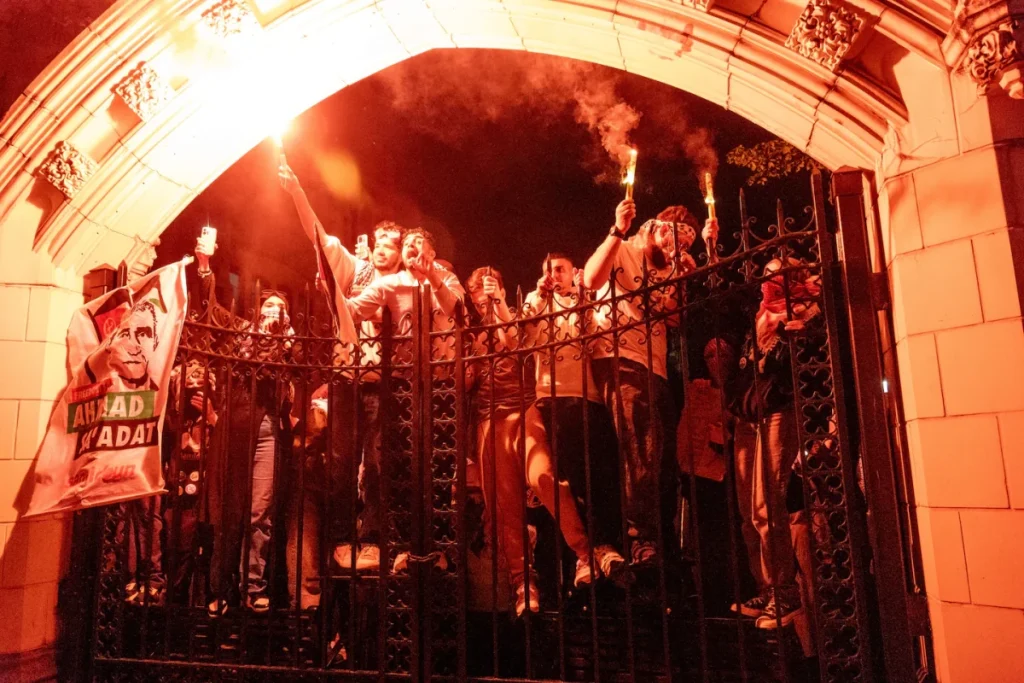
Repeatedly over the past year, in tones ranging from supportive sympathy to cold fury, Biden has called on Netanyahu to focus on a strategic plan for peace rather than tactical military and political victories. He has appealed to the Israeli leader, in public statements and private conversations, to temper rather than feed the Israeli people’s justifiable desire for revenge.
But Netanyahu has publicly rejected U.S. entreaties and proposals for a cease-fire, both in Gaza and now in Lebanon. He has accused Biden of slow-walking arms shipments. And U.S. and foreign officials familiar with the Gaza hostage-release talks say Netanyahu — as well as Hamas — has repeatedly undermined them by making new, last-minute demands.
Time and again, according to U.S. officials, Israel has blocked or delayed humanitarian aid in Gaza, often while denying it has done so. Under the security of a U.S. defense guarantee, it has carried out attacks in Gaza, the occupied West Bank, Lebanon, Syria and Iran without telling its American allies in advance and despite U.S. warnings against escalation.
Biden has had some successes — most achieved through strenuous effort, many short-lived.
Without pressure from the United States, officials say, Israel would not have allowed even a minimal amount of humanitarian assistance to flow into Gaza. Unprecedented direct attacks by Iran on Israel have been thwarted with help from U.S. military might. Alternating pleas and threats from Biden and his aides appeared to moderate Israel’s eventual offensive in Rafah, begun in early May, and the administration has noted that the daily toll of Palestinian deaths has declined compared with earlier in the year.
1:30U.S.-led negotiations led to a brief cease-fire in Gaza last fall but nonstop effort to stop the fighting has since failed to achieve a permanent truce. (Video: Joy Sung/The Washington Post, Photo: Illustration by The Washington Post; Demetrius Freeman/The Washington Post; Heidi Levine for The Washington Post/The Washington Post)
U.S.-led negotiations brought a brief cease-fire last fall to Gaza, and the release of more than 100 Hamas-held hostages. But nonstop efforts to free the rest, stop the fighting and care for besieged Gazans have failed.
Few weeks have gone by this year that Biden did not declare that talks were on the verge of a deal. But there is now little hope that a Gaza agreement will be reached before the president leaves office.
The number of hostages still thought to be alive has dwindled, with some murdered by Hamas and others inadvertently killed by Israeli bombardment. Hundreds of thousands of Israelis staged regular protests for much of the year over Netanyahu’s failure — or refusal — to reach a negotiated deal for the hostages’ release, while others, including key members of the coalition that keeps him in power, demanded that the Gaza war go on until every vestige of Hamas is vanquished.
The embrace
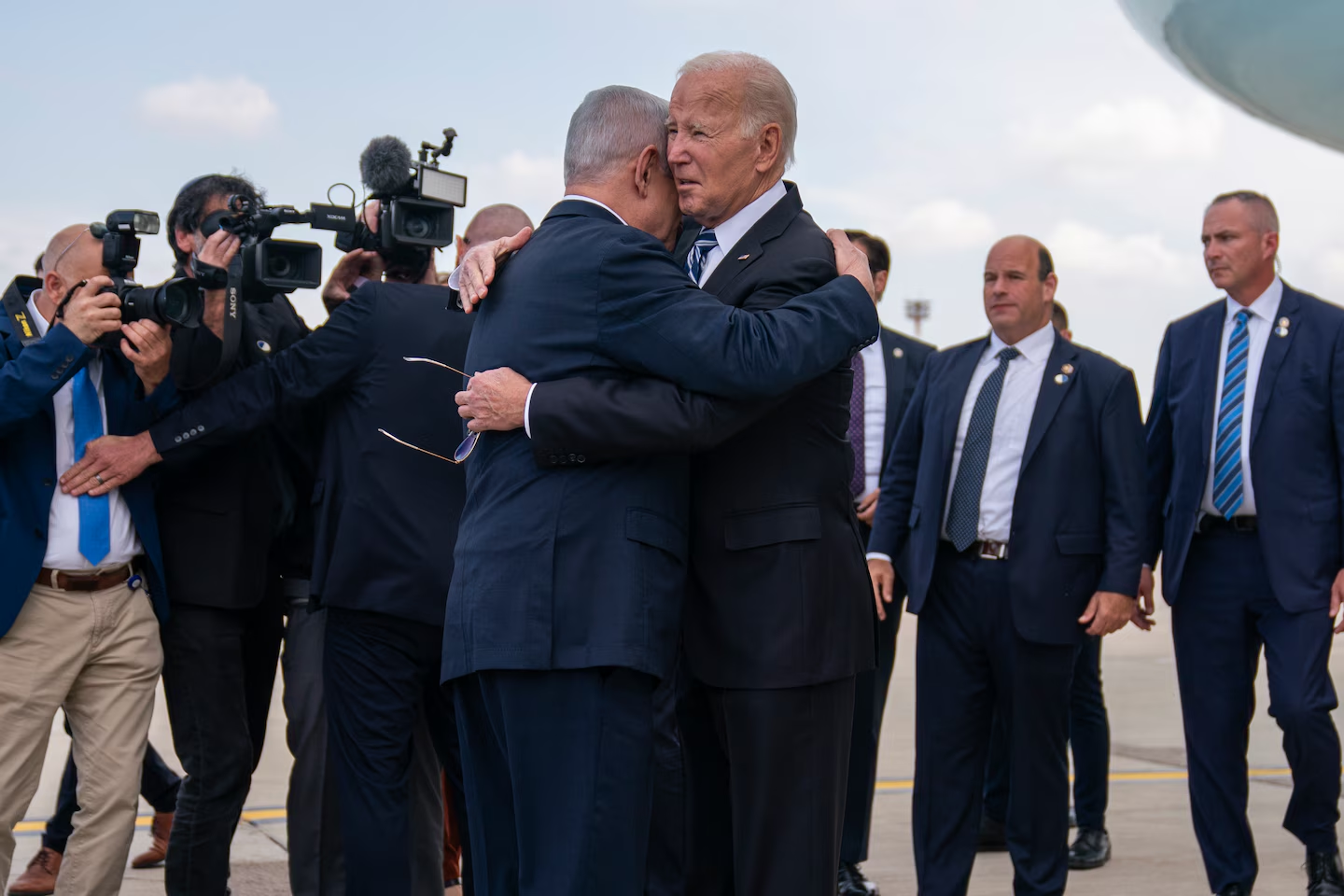
As Biden juggled the often-conflicting priorities of “unshakable” support for Israel, protection of civilians and avoidance of a regional war, the emphasis of the U.S. effort changed as conditions on the ground evolved.
Immediately after the Hamas attacks, as Hezbollah and Israel rained missiles on each other across the Lebanese border, the administration successfully urged Netanyahu’s government not to open a second front with escalation in the north. But in Gaza, the U.S. emphasis quickly shifted to ameliorating what officials saw as a humanitarian crisis in the making.
Within the first week, 2,500 Palestinians were killed, according to local health authorities, in Israel’s bombardment of residential areas in northern Gaza where it said Hamas was operating. As the Israelis readied a full-scale ground offensive, civilians fleeing to safety began to crowd into central and southern Gaza.During a four-day pause in fighting in the Gaza Strip, drone footage taken in Gaza City on Nov. 26 shows wide-scale destruction after seven weeks of war. (Video: Reuters)
Israel had closed all exit and entry points to the 141-square-mile territory. Deeply dependent on goods and energy imported through Israel, Gaza had already seen its lights go out. “No electricity, no food, no water, no fuel” would enter the enclave until Hamas was wiped out, Israeli Defense Minister Yoav Gallant vowed.
Biden dispatched Defense Secretary Lloyd Austin and Blinken to Tel Aviv within days of each other to demonstrate American support. But in private conversations, Austin — a retired four-star general who knew the challenges of urban warfare from the fight against the Islamic State in Iraq — and Blinken separately urged Israeli officials to establish a flow of humanitarian aid and to think through how a scorched-earth campaign in Gaza fit into a strategy for long-term peace and stability.
In a bunker beneath the Kirya — the Tel Aviv government complex and headquarters of the Israel Defense Forces — Blinken, Netanyahu and their top advisers huddled for hours about a week after the Hamas attacks, as air-raid sirens wailed above them. Biden intended to visit, Blinken said, but he was “not getting on a plane unless we have humanitarian access opened up.” Both sides dug in their heels. “Bibi was saying, ‘My politics here won’t allow it. They don’t want a single aspirin to get into Gaza. … The Israeli people want revenge,’” one official recalled, using Netanyahu’s nickname.
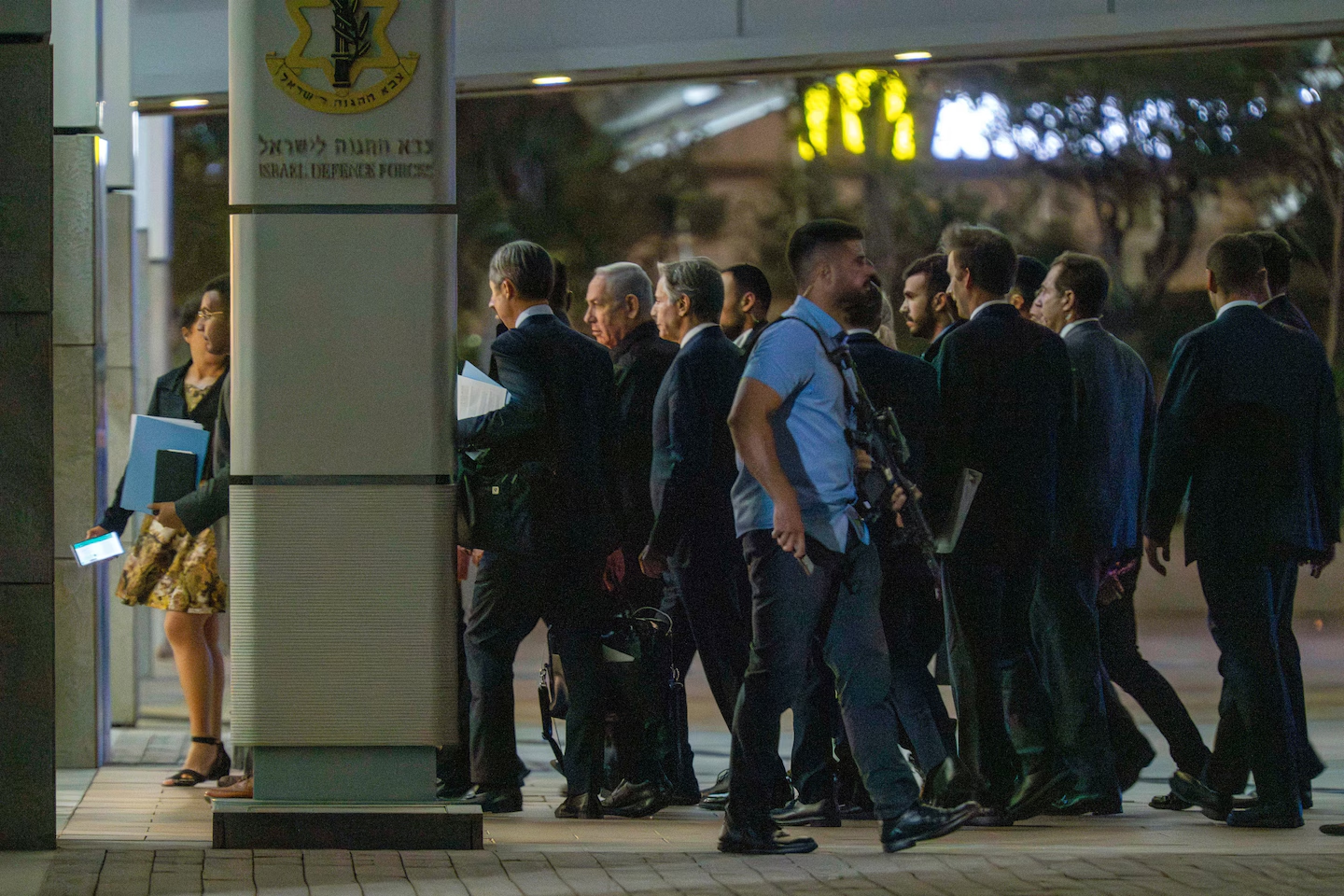
A weary-looking Blinken emerged before dawn the next day to announce to waiting reporters that Biden was coming. He reaffirmed U.S. support and noted that the president had ordered two U.S. aircraft carrier groups to the region as a warning to “any actor, state or non-state” not to take advantage of the situation.
Israel and the United States were working on a plan for humanitarian assistance, he said, but there was no announced agreement to immediately open the border.
Two days later, as Biden was preparing to depart the White House for Israel, news broke that Israeli warplanes had apparently bombed a hospital in northern Gaza, reportedly killing hundreds. In an impromptu meeting in the Treaty Room, the president and senior aides debated whether to cancel the trip.
As takeoff time approached, Biden called Netanyahu, who insisted that Israel was not responsible for the hospital strike. Biden decided to go, even before evidence emerged making clear that the hospital had been struck by an errant missile fired by another militant group in Gaza.
Netanyahu was waiting on the tarmac when Air Force One landed in Tel Aviv on Oct. 18, and the two men embraced. Photos of the bear hug would soon become emblematic, for better or worse, of Biden’s no-matter-what support for Israel, though he spent only seven hours on the ground.
In an Oval Office speech upon his return, Biden tied together U.S. support for Israel and Ukraine, again using the phrase “an inflection point in history,” and said he was submitting to Congress a massive package of military assistance for both.
Biden’s team was satisfied that in Israel and at home, the president had made the points that needed to be made. “He made clear our support was unqualified, the morally right thing to do,” recalled David Satterfield, a senior U.S. diplomat with long Middle East experience, whom Biden called out of retirement to manage the looming humanitarian catastrophe in Gaza.
But the president also “made it clear” to Netanyahu that “you’ve got to treat the humanitarian side of this with as much seriousness as the kinetic side,” Satterfield said. “Were maximum efforts made by Israel? No. They were not then and they certainly are not now.”
A week after Biden’s visit, only 20 aid trucks had made their way into Gaza. Then Israel launched its ground invasion.
“We were advised not to do so,” an Israeli official said. In addition to warnings from Biden and Blinken, the Americans “sent three generals with experience in Iraq who tried to kind of frighten us that every day we’re going to lose 200 soldiers.”
But the die was already cast, said the Israeli official. “I don’t think there’s any way that any sensible government could not do that after Oct. 7. If the U.S. was attacked that way, you could imagine what the U.S. would do.”
Carrots and sticks
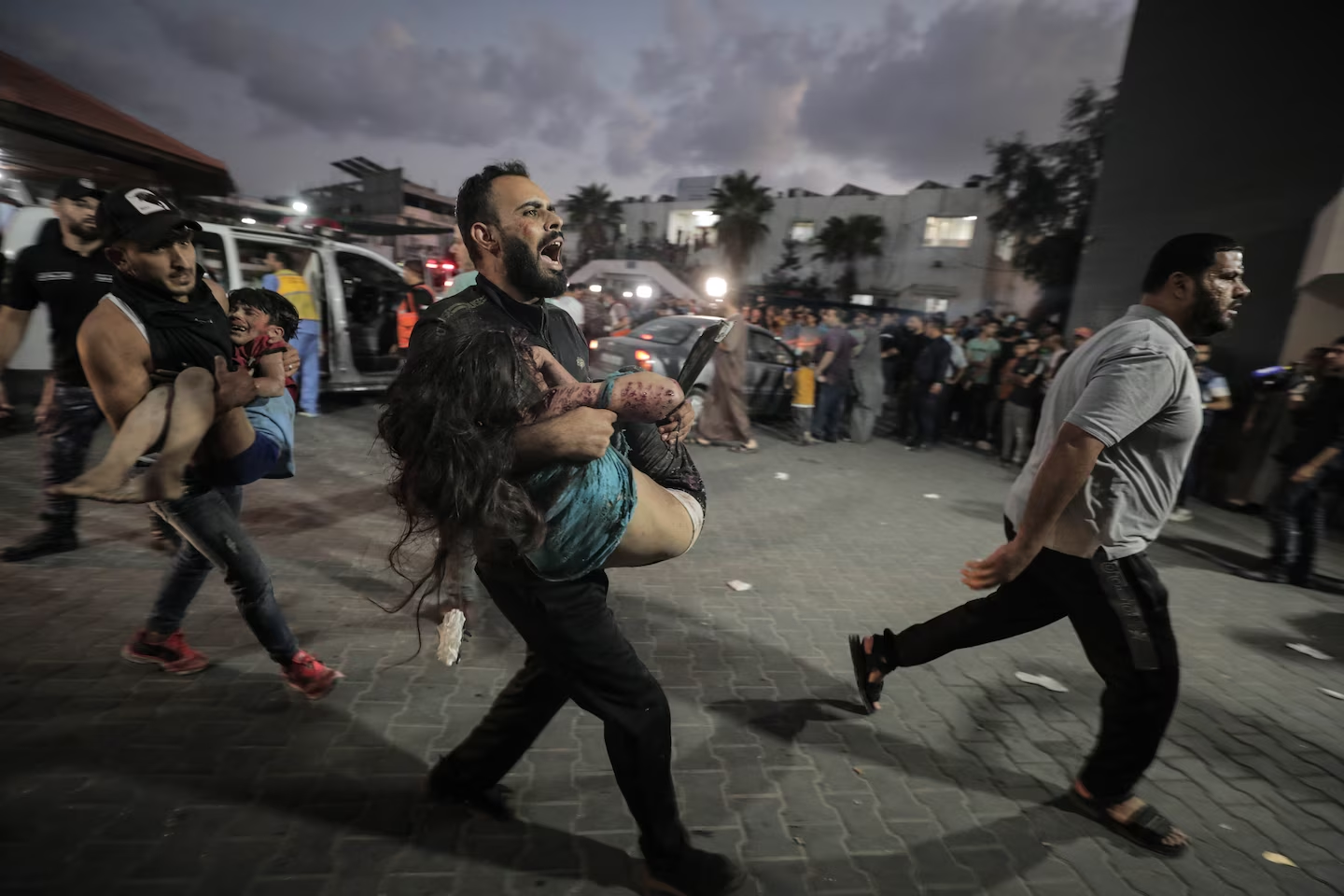
Weeks of frequent calls between Biden and Netanyahu slowed as the new year dawned. The Palestinian death toll soared, aid organizations warned of possible famine and Biden’s patience wore thin. Israel risked losing international support with its “indiscriminate bombing” in Gaza, Biden told Jewish donors to his reelection campaign at a White House gathering for Hanukkah.
Protests against the president’s support for Israel were becoming common at his campaign appearances, and inside the administration — particularly in the State Department — a growing number of staffers were objecting to ongoing arms shipments.
At the U.N. Security Council, the United States had vetoed resolutions demanding an immediate cease-fire, arguing that they omitted condemnation of Hamas. Russia voted in favor, along with a majority of the member states, leading some in the administration to worry that Washington was ceding moral high ground to Moscow. It was clear that world attention had shifted from Hamas’s brutality to Israel’s brutal response.
On Feb. 11, after his first conversation with Netanyahu in weeks, Biden told reporters that Israel’s military campaign in Gaza, where the deaths by then reportedly had reached 28,000, was “over the top.”
Netanyahu vowed to continue until “total victory,” administration officials said. He expressed little interest in the plight of Gaza civilians, many of whom he believed were in league with if not members of Hamas. And he poured cold water on a U.S. “framework” proposal for a six-week pause in the fighting that would allow the distribution of aid and the release of more hostages.
The prime minister maintained that he had no political space for pulling back in Gaza, and that the Israeli public did not want assistance going directly from Israel into the enclave. To demonstrate U.S. concern over the Palestinians, and give Netanyahu space by providing U.S. “skin in the game,” according to U.S. and Israeli officials, Biden ordered the U.S. military to airdrop American assistance and to construct a pier in the Mediterranean Sea to the Gaza shore for maritime aid delivery from abroad.
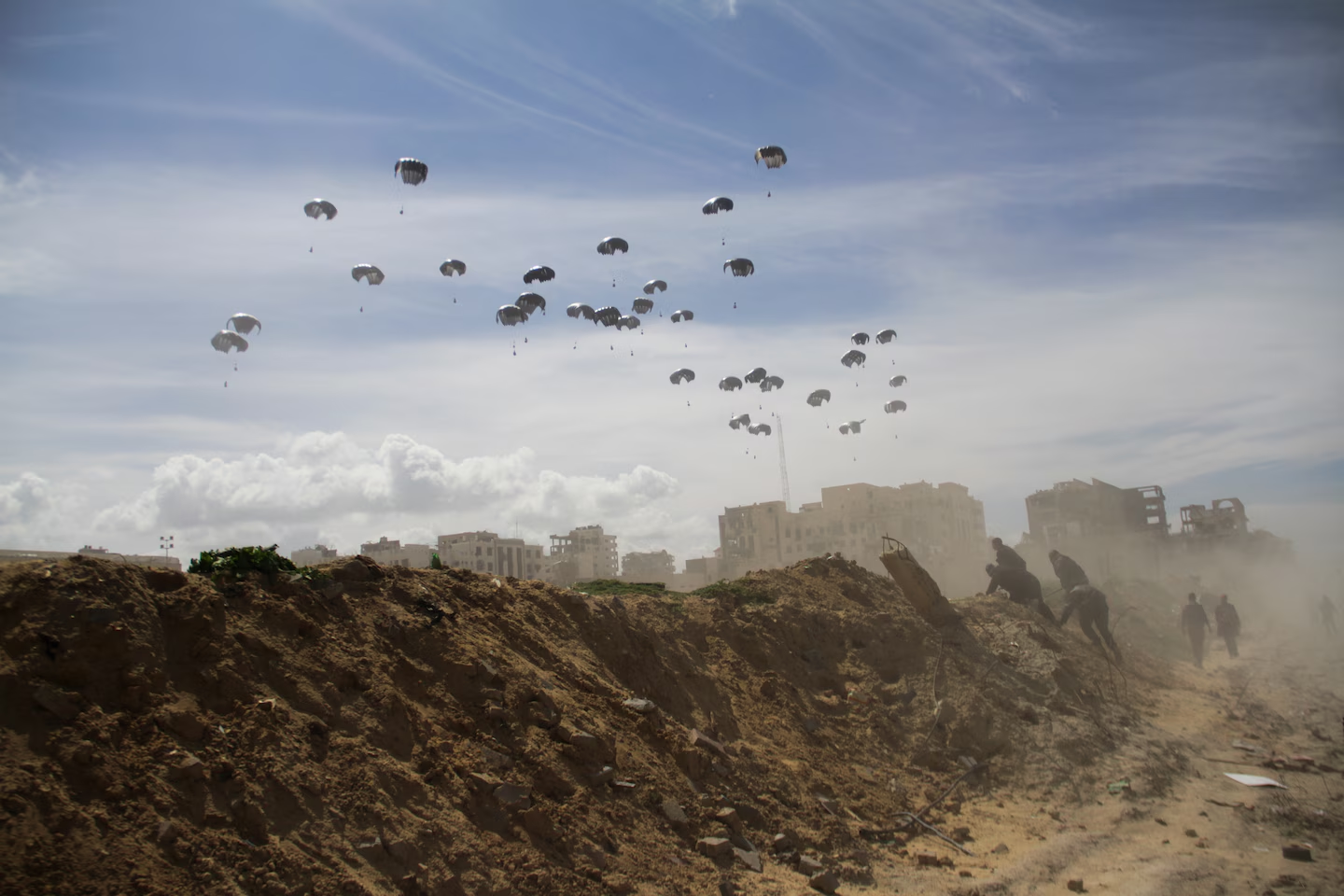
Neither did much to alleviate the humanitarian catastrophe. Some of the airdropped aid landed in the sea. Videos captured desperate people fighting on the beach over pallets of ready-to-eat military meals. The pier, removed and reinstalled several times as it was overcome by rough seas, operated only 20 days in total before the Americans permanently removed it.
U.S. officials privately scorned Netanyahu’s public declaration that the ratio of militants to civilians killed in Gaza was 1 to 1. They similarly rejected Israel’s assertions that assistance wasn’t reaching the starving population because Hamas was looting the aid convoys. And still,Blinken told Congress that the State Department had “currently” found no evidence that Israel was intentionally blocking food and fuel from entering Gaza, despite internal reports saying just that from the U.S. Agency for International Development and others on the ground.
Amid criticism in the heated presidential contest that Biden was doing too much or too little, U.S. weapons transfers continued largely unabated. To use the language of diplomacy: Washington kept giving Israel carrots, while Israel seemed to know that the U.S. stick was more of a twig.
Beyond occasional outbursts by Biden and off-the-record comments by officials, the administration wrestled with publicly venting criticism it knew would give aid and comfort to Hamas, even as it told Israel that both countries were losing international standing. No announcement was made when Biden, at one point in the spring, halted a shipment of the 2,000-pound bombs Israel had dropped liberally across northern Gaza — as a signal the United States would not abide their use in Rafah.
The Israeli government, which had not been informed of the halt, was furious. “They stopped a delivery which was approved by Congress, paid for by Israel. Every day [that] those munitions were on the ship” and not moving, “we in the state of Israel paid the fine of $35,000,” the Israeli official said. “That’s how we learned about it.”
The Rafah invasion

Biden met every day, sometimes several times a day, with aides about Gaza, officials said. But it was clear that his counterpart in Israel was far beyond the point of asking the United States for permission.
When the two leaders next spoke in mid-March, the president again raised concerns about humanitarian aid and Rafah. He asked Netanyahu to send his senior aides to Washington to explain in person exactly what Israel was planning — an operation it insisted was necessary to eliminate four remaining Hamas battalions and ensure that the militants could no longer smuggle weapons across the Egyptian border.
Biden didn’t dispute the need for action, officials said, but warned that the United States would not support any operation that did not take civilian welfare into account and avoid the heavy death toll that had resulted from operations in the north. Local health authorities said, and aid organizations agreed, that the majority of civilians killed were women and children.
What “not support” meant in terms of policy was unclear. The holdup of 2,000-pound bombs was a “shot across the bow,” officials said, but it was largely symbolic. While a direct confrontation with Hezbollah in the north would be challenging, Israeli stockpiles were sufficient for an extended war with Hamas in Gaza.
Daily headlines tracked in seeming lockstep the rising death toll in Gaza and Biden’s declining poll numbers. The administration continued to appeal to Israel to mitigate civilian harm, while occasionally appeasing regional allies — and Democrats at home — who were appalled by Israel’s war tactics.
When in late March the United States for the first time refused to veto a U.N. Security Council vote demanding a cease-fire — a condemnation with symbolic importance but largely without consequences — Netanyahu abruptly canceled his top aides’ face-to-face meeting with Biden. Instead, they arranged to talk virtually, on April 1, a session that ultimately fell between Israel’s strikes that day on Iranian officials in Damascus and the World Central Kitchen workers in Gaza.

While the first attack threatened regional escalation with Iran and its proxies, the second was a blow to Israel’s hopes of pushing UNRWA — the U.N. agency created to care for Palestinians displaced by the creation of Israel and the biggest humanitarian provider in Gaza — out of existence. Netanyahu’s government charged that UNRWA-administered schools taught children to seek the destruction of Israel and that many of its employees were Hamas members. UNRWA had no reason for being, in Israel’s view: It simply perpetuated the idea that Palestinians were “refugees” waiting to someday return to a “homeland” that was now Israel.
Instead, the government looked to other humanitarian groups like World Central Kitchen to provide aid. The Israelis were particularly fond of WCK; as far as they were concerned, it could take over the entire food assistance program in Gaza. An IDF investigation found that the drone strike on the WCK convoy was the result of “errors” and “contrary” to military procedures. Two officers were fired and others reprimanded.
But the main subject of the April 1 meeting was Rafah. They had to “finish the job” of destroying Hamas, the Israelis said; a major operation there was unavoidable.
In the Situation Room, senior national security officials made the case to their Israeli counterparts that Hamas was no longer an effective military force and that a full-scale Rafah offensive was not worth the potential cost in civilian lives and international opprobrium. A more restrained approach with intelligence-based, targeted operations, they argued, would suffice.
Rafah’s population — swollen with more than a million refugees from the north, many now crowded in squalid camps on the beach and along the Egyptian border — had nowhere else to go. Unless Israel could offer a comprehensive and “executable” plan to move them in advance of an offensive and supply their needs, the administration would continue to publicly withhold its support.
The Americans appreciated what Israel was up against in Gaza, where Hamas’s tunnel network — far more extensive and sophisticated than estimated at the start of the war — made the United States’ most challenging urban battles in Iraq look straightforward. One veteran diplomat called it the “Paris Metro of tunnels.”
But they had long believed that Israel’s conduct of the war would not achieve lasting control of the enclave or turn Gazans against the Hamas militants who had run the place for years. Air and ground operations in northern Gaza had decimated Hamas strongholds and, often, surrounding civilian structures before moving on, leaving behind an angry and destitute population and allowing the militants to repeatedly return to areas Israel had declared “cleared.”
In the early days of the war, the Pentagon had been struck by the extent to which traumatized Israelis, moving forward to destroy Hamas, “could not articulate achievable military objectives,” a former official said.
While the IDF had briefed the administration extensively in the months since about its targeting procedures, which were almost identical to those of the U.S. military, American officials felt that what they had seen in Gaza didn’t add up. Part of it was the IDF’s more permissive sense of “proportionality,” the requirement under international law to consider the extent of civilian casualties relative to the value of enemy targets.
But U.S. officials increasingly faulted Israel on what the military calls “weaponeering” — the selection of appropriate munitions for a target after calculating their impact on civilians and structures in the area around it. “There’s a way to do this where you can be very effective and not create so many casualties,” a senior official said.
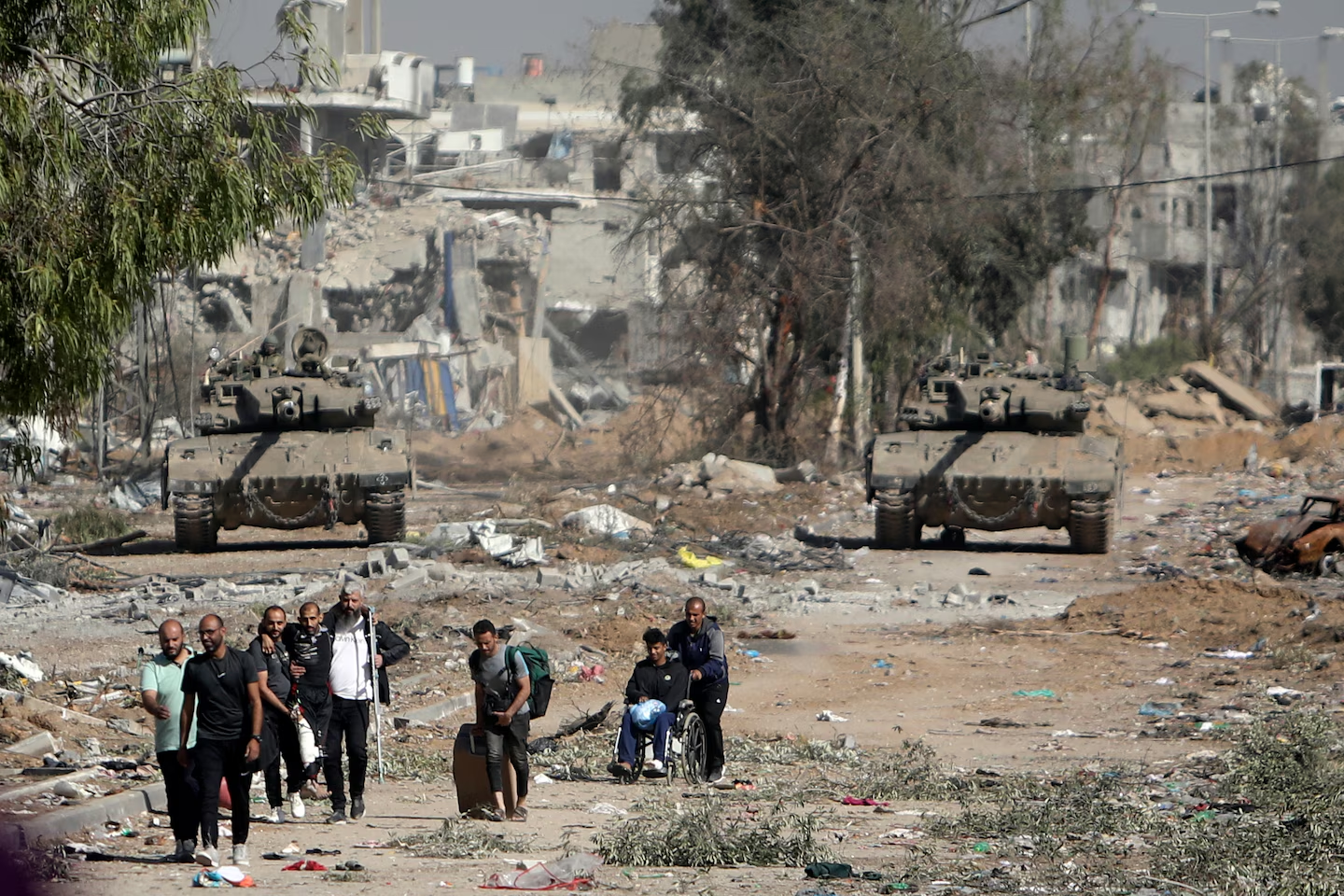
By the end of April, the humanitarian situation, while still far from perfect, had improved. However tragic, the WCK disaster had led to significant Israeli concessions. Long-closed border posts were reopened to expanded aid deliveries.
But once a Rafah operation started, the United States repeatedly warned Israeli officials, “you’re going to have a million people hitting the roads. And because of that, you had better be prepared to have places for them to go where there is suitable shelter and suitable provision of basic services and care,” said Satterfield, in charge of U.S. humanitarian concerns. Roads would have to be cleared and alternative safe routes designated around the incoming tanks and bombing runs.
Israel dismissed the U.S. concerns, insisting that it had a plan and, in any case, nowhere near that number would flee Rafah. The Americans “were saying, ‘Don’t start and don’t do anything before you have the full, complete solution for each and every person,’ which would take many months,” the Israeli official said. “And we said, ‘We can’t wait.’”
By the time Blinken again traveled to Israel in early May, the Israelis had adjusted their attack strategy somewhat but, in the U.S. view, still had an inadequate humanitarian plan for the operation.
On a visit to the Kerem Shalom crossing into Gaza, on the Israeli border near Rafah, Blinken’s convoy passed scores of armored vehicles marshaled ahead of the planned offensive. But U.S. officials felt they had gotten assurance that the timing of the operation would depend on when the evacuation and humanitarian goals had been met.
Instead, they were taken aback when the assault began days later, following a surprise Hamas attack on the Israeli side of Kerem Shalom that killed four IDF soldiers. Hundreds of thousands of Gazans began to flee, many to evacuation areas designated by Israel that ultimately were hit by airstrikes.
“Everything we had talked about as concerns we had, had happened. There were no alternative routes. None. The flood of people did equal a million. … There was no place for them to go and no alternative services,” Satterfield said. “The misery of Gaza’s displaced population from Rafah was even greater in reality than we predicted.”
The Israeli official defended his government’s conduct, acknowledging shortcomings in its ability to enable aid and shelter but insisting that the all-out humanitarian crisis Israel’s critics had predicted was not occurring.
“It’s not a rosy picture, of course,” he said. “War is war.”
‘Take the win’
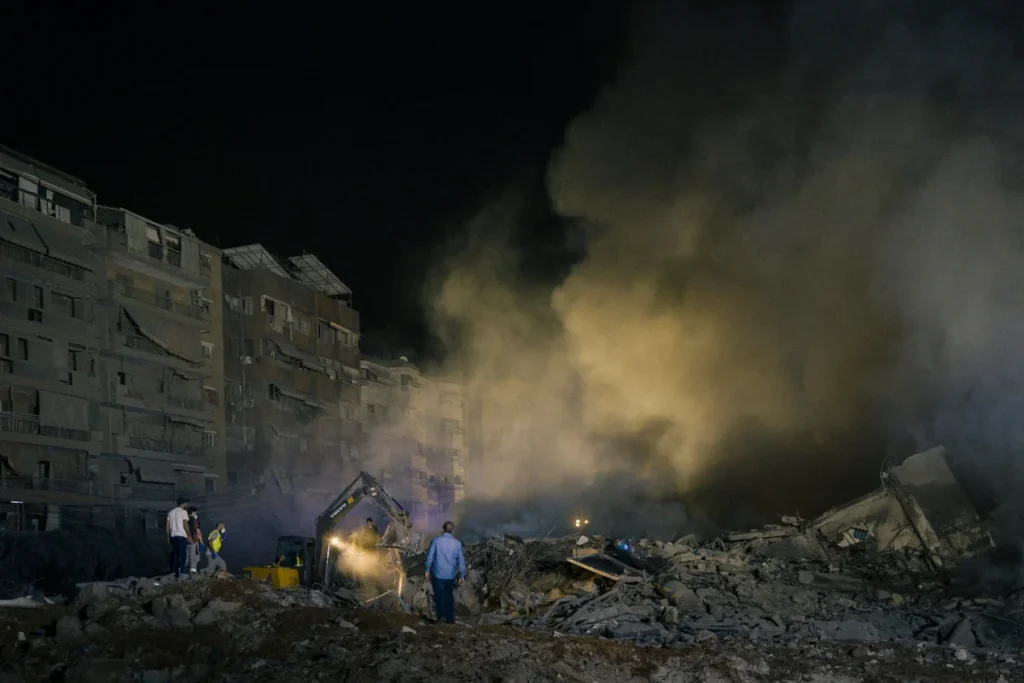
Even as Rafah was still being planned, Israel and the United States were preparing for Tehran’s response to the April 1 strike in Damascus that killed senior IRGC commanders. It came on April 13. Biden and his team monitored in real time reports of more than 300 Iranian missiles and drones heading toward Israel, virtually all of them shot down before reaching their targets by Israeli air defenses and U.S. aircraft and ships. By 9 p.m. in Washington, it was over, and the president placed a call to Netanyahu.
His message was simple: “Take the win.” Israel, with long-promised U.S. support, had successfully repelled the first-ever direct attack from Iran. Let it end there, Biden said. His concern was that any Israeli desire to have the last word militarily would keep the region locked in a cycle of dangerous brinkmanship.
“We did not listen to that advice,” a senior Israeli official said of Biden’s appeal. “For good reason, because in our region, defense is not enough.”
Israel says it targeted a Hezbollah leader in Beirut suburb
Israel said it targeted a Hezbollah commander in the Beirut area on July 30 in retaliation for a cross-border attack three days earlier that killed 12 children. (Video: Reuters)
Six days after the Iranian barrage, the IDF struck near a military site in central Iran. Then, on the last day of July, an Israeli strike in a Beirut suburb killed Hezbollah operative Fuad Shukr, a top deputy to Nasrallah. Hours later, Hamas political chief Ismail Haniyeh was assassinated with a bomb planted in a Tehran guesthouse.
American officials, who got only a general tip-off from Israel ahead of the operation against Shukr and none before Haniyeh, feared that the abrupt killings left American troops at Middle Eastern bases in unnecessary danger. U.S. forces in the region had already endured months of rocket and drone attacks from Iranian-supported militias in Iraq and Syria — resulting in dozens of injuries and the deaths of three soldiers in Jordan. The Pentagon feared that Iran could lose control of those groups, which could easily dial up their attacks on U.S. forces.
Biden’s policy was ironclad: If Israel faced an external attack that might overwhelm its defenses, America would help repel it. But if Iran had been willing to break a 75-year taboo and directly attack Israel because of a strike on a senior IRGC official in Syria, what would Tehran attempt now?
The Israeli response was yet another example of what Austin privately characterized as Netanyahu’s government “playing with house money”: taking big shots at its adversaries, knowing that the United States, as Israel’s chief ally, would throw its military and diplomatic weight behind it.
Some speculated that Biden’s new lame-duck status had further emboldened Netanyahu, who thought a possible Trump return to the White House would mean more U.S. support for Israel and less complaining. Just days before the attacks on Shukr and Haniyeh, after giving a table-thumping speech to Congress, Netanyahu had visited the former president and newly crowned Republican presidential nominee at his Florida residence.
In August, as the Pentagon began positioning ships and planes closer to Israel in anticipation of another round of Iranian or Hezbollah retaliation, the administration launched a diplomatic scramble to head off what officials yet again feared could spiral into a regional war. Blinken appealed to the Iraqi prime minister to use his country’s close ties to Tehran. Arab allies, including Jordan and Egypt, were enlisted to reach out to Iran, and the White House communicated back-channel warnings to Iranian officials.
But the Pentagon also warned Israel that U.S. support would not extend to unnecessary offensive operations. “After the Shukr strike, we were very clear that a preemptive strike in which they are the aggressor is far different than defending themselves in a responsive fashion,” a senior defense official said.
When Blinken again visited in August, there were indications that the Israelis were planning for a major offensive against Hezbollah. “Doing something big,” he told them, “will be seen as you acting irresponsibly, not just by Hezbollah and Iran but by many of your friends. And you can’t really afford to do it at this moment,” a U.S. official recounted.
For months, White House envoy Amos Hochstein had been trying to broker a diplomatic truce between Israel and Hezbollah, which had said it would stop firing across Israel’s border only when a cease-fire was reached in Gaza.
But the Gaza cease-fire negotiations remained stuck on intransigent demands from both sides. Anxious to be seen as “steering” the situation rather than being steered by events outside his control, Biden at the end of May had himself announced an updated version of the “framework” for an Israel-Hamas deal. The three-phase plan would lead to the release of all hostages, a permanent cease-fire that would allow a new flood of humanitarian aid, and the eventual reconstruction and installation of a new Gaza government to replace Hamas.
As summer waned, the talks were still at a stalemate.
On July 27, after a rocket strike killed 12 youngsters playing on a soccer field in the Golan Heights — a sliver of land bordering Syria and Lebanon that Israel seized during the 1967 war — Netanyahu vowed that Hezbollah would “pay a heavy price.”
On Sept. 17, more than a dozen people were killed and thousands injured across Lebanon when electronic pagers used by Hezbollah simultaneously exploded in what appeared to be an unprecedented sabotage attack by Israel. Even more died the next day when hundreds of Hezbollah walkie-talkies blew up.
In the days that followed, Israel launched hundreds of airstrikes across Lebanon, targeting Hezbollah commanders but killing many Lebanese civilians in the process. Israeli military chiefs indicated that a ground attack was soon to follow. As Hezbollah responded with its own rocket barrage into northern Israel, including the first-ever ballistic missile targeting Tel Aviv, Iran said Israel’s attacks would not be tolerated.
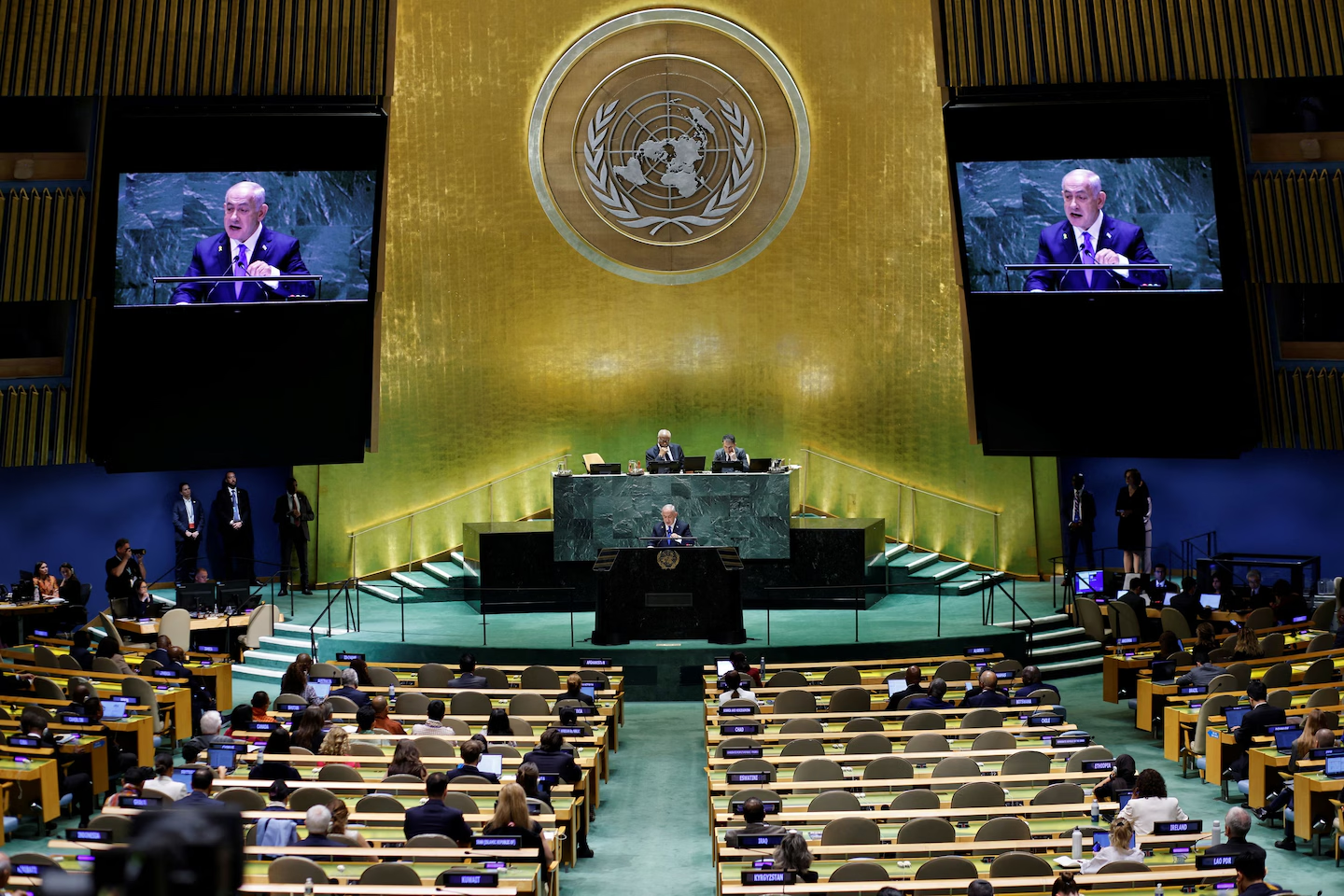
In mid-September, top officials from across the world gathered in New York for the annual U.N. General Assembly. American diplomats feverishly walked the hallways of the U.N. headquarters building, calling for de-escalation in Lebanon and avoidance of regional war.
That Tuesday, Biden took the stage for his last speech as president before the General Assembly. He cracked a joke about looking younger than his 81 years, then with grim determination appealed to the assembled dignitaries for world calm. “We are at another inflection point,” he said.
Three days later, as Netanyahu walked to the same podium to berate the international organization as a “swamp of antisemitic bile,” Israeli jets were about to bomb Beirut’s southern suburbs in a massive strike that would kill Nasrallah, Hezbollah’s longtime leader, and put the region on the brink of all-out war.
He did not call Biden to inform him in advance.
Leave a Reply
You must be logged in to post a comment.